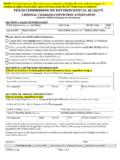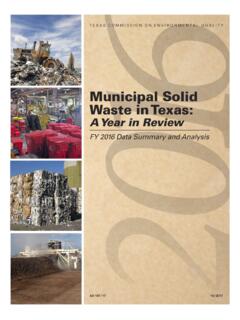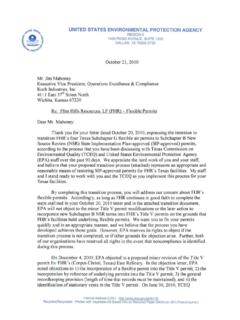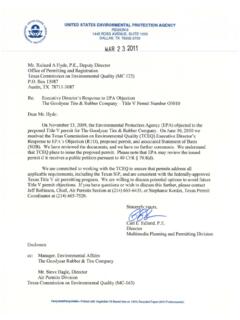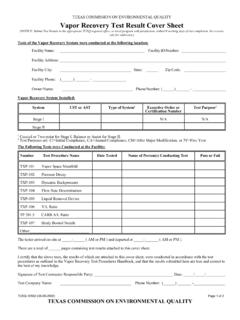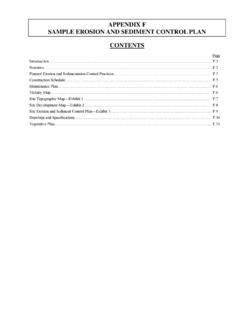Transcription of TEXAS COMMISSION ON ENVIRONMENTAL UALITY
1 -1-August 21, 2003 TEXAS COMMISSION ON ENVIRONMENTAL QUALITYD escription of BMPsEROSION control BMPsTemporary VegetationDescription: Vegetation can be used as a temporary or permanent stabilization technique for areasdisturbed by construction. Vegetation effectively reduces erosion in swales, stockpiles, berms, mild tomedium slopes, and along roadways. Other techniques such as matting, mulches, and grading may berequired to assist in the establishment of : The type of temporary vegetation used on a site is a function of the season and the availability of waterfor irrigation. Temporary vegetation should be selected appropriately for the area.
2 County agricultural extension agents are a good source for suggestions for temporary vegetation. All seed should be high quality , Dept. of Agriculture certified : Grading must be completed prior to seeding. Slopes should be minimized. erosion control structures should be installed. Seedbeds should be well pulverized, loose, and uniform. Fertilizers should be applied at appropriate rates. Seeding rates should be applied as recommended by the county agricultural extension agent. The seed should be applied uniformly. Steep slopes should covered with appropriate soil stabilization 21, 2003 Blankets and MattingDescription: Blankets and matting material can be used as an aid to control erosion on critical sites duringthe establishment period of protective vegetation.
3 The most common uses are in channels, interceptorswales, diversion dikes, short, steep slopes, and on tidal or stream :New types of blankets and matting materials are continuously being developed. The TEXAS Department ofTransportation (TxDOT) has defined the critical performance factors for these types of products and hasestablished minimum performance standards which must be met for any product seeking to be approved foruse within any of TxDOT s construction or maintenance activities. The products that have been approvedby TxDOT are also appropriate for general construction site stabilization. TxDOT maintains a web site which is updated as new productsare : Install in accordance with the manufacturer s recommendations.
4 Proper anchoring of the material. Prepare a friable seed bed relatively free from clods and rocks and any foreign material. Fertilize and seed in accordance with seeding or other type of planting plan. erosion stops should extend beyond the channel liner to full design cross-section of the channel. A uniform trench perpendicular to line of flow may be dug with a spade or a mechanical trencher. erosion stops should be deep enough to penetrate solid material or below level of ruling in sandy soils. erosion stop mats should be wide enough to allow turnover at bottom of trench for stapling, whilemaintaining the top edge flush with channel : Mulching is the process of applying a material to the exposed soil surface to protect it fromerosive forces and to conserve soil moisture until plants can become established.
5 When seeding critical sites,sites with adverse soil conditions or seeding on other than optimum seeding dates, mulch material shouldbe applied immediately after seeding. Seeding during optimum seeding dates and with favorable soils andsite conditions will not need to be : Mulch may be small grain straw which should be applied uniformly. On slopes 15 percent or greater, a binding chemical must be applied to the 21, 2003 Wood-fiber or paper-fiber mulch may be applied by hydroseeding. Mulch nettings may be used. Wood chips may be used where :Mulch anchoring should be accomplished immediately after mulch placement. This may be done by oneof the following methods: peg and twine, mulch netting, mulch anchoring tool, or liquid mulch : Sod is appropriate for disturbed areas which require immediate vegetative covers, or wheresodding is preferred to other means of grass establishment.
6 Locations particularly suited to stabilization withsod are waterways carrying intermittent flow, areas around drop inlets or in grassed swales, and residentialor commercial lawns where quick use or aesthetics are factors. Sod is composed of living plants and thoseplants must receive adequate care in order to provide vegetative stabilization on a disturbed : Sod should be machine cut at a uniform soil thickness. Pieces of sod should be cut to the supplier s standard width and length. Torn or uneven pads are not acceptable. Sections of sod should be strong enough to support their own weight and retain their size and shape whensuspended from a firm grasp.
7 Sod should be harvested, delivered, and installed within a period of 36 : Areas to be sodded should be brought to final grade. The surface should be cleared of all trash and debris. Fertilize according to soil tests. Fertilizer should be worked into the soil. Sod should not be cut or laid in excessively wet or dry weather. Sod should not be laid on soil surfaces that are frozen. During periods of high temperature, the soil should be lightly 21, 2003 The first row of sod should be laid in a straight line with subsequent rows placed parallel to and buttingtightly against each other. Lateral joints should be staggered to promote more uniform growth and strength.
8 Wherever erosion may be a problem, sod should be laid with staggered joints and secured. Sod should be installed with the length perpendicular to the slope (on the contour). Sod should be rolled or tamped. Sod should be irrigated to a sufficient depth. Watering should be performed as often as necessary to maintain soil moisture. The first mowing should not be attempted until the sod is firmly rooted. Not more than one third of the grass leaf should be removed at any one SwaleInterceptor swales are used to shorten the length of exposed slope by intercepting runoff, prevent off-siterunoff from entering the disturbed area, and prevent sediment -laden runoff from leaving a disturbed may have a v-shape or be trapezodial with a flat bottom and side slopes of 3:1 or flatter.
9 The outflowfrom a swale should be directed to a stabilized outlet or sediment trapping device. The swales should remainin place until the disturbed area is permanently : Stabilization should consist of a layer of crushed stone three inches thick, riprap or high velocity erosion control mats. Stone stabilization should be used when grades exceed 2% or velocities exceed 6 feet per second. Stabilization should extend across the bottom of the swale and up both sides of the channel to a minimumheight of three inches above the design water surface elevation based on a 2-year, 24-hour : An interceptor swale should be installed across exposed slopes during construction and should interceptno more than 5 acres of runoff.
10 All earth removed and not needed in construction should be disposed of in an approved spoils site so thatit will not interfere with the functioning of the swale or contribute to siltation in other areas of the site. All trees, brush, stumps, obstructions and other material should be removed and disposed of so as not tointerfere with the proper functioning of the 21, 2003 Swales should have a maximum depth of feet with side slopes of 3:1 or flatter. Swales should havepositive drainage for the entire length to an outlet. When the slope exceeds 2 percent, or velocities exceed 6 feet per second (regardless of slope),stabilization is required.
